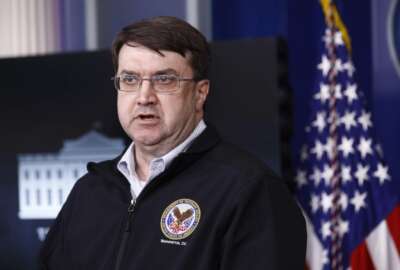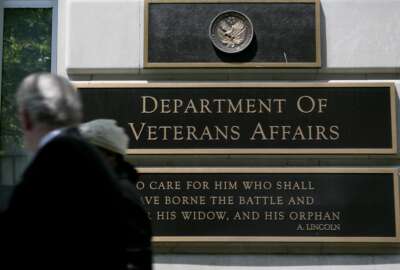‘Confusing’ chain of command hangs over Veterans Affairs police reforms
Lawmakers want leadership to address problems at the VA's law enforcement arm, including high officer turnover and gaps in tracking use-of-force incidents
Best listening experience is on Chrome, Firefox or Safari. Subscribe to Federal Drive’s daily audio interviews on Apple Podcasts or PodcastOne.
The Department of Veterans Affairs is struggling to reform its law enforcement arm, and lawmakers are pressing the VA to sort out a confusing leadership structure that could be holding back other changes to the police force.
With about 5,000 officers and support staff, the VA police force is among the 10 largest federal law enforcement organizations in the country. The force is responsible for protecting patients, staff and visitors at Veterans Health Administration properties and co-located VA facilities.
But the VA has struggled to recruit and retain officers, with low pay and benefits leading to high turnover and staffing shortages in recent years, according to the department’s inspector general. Congress is also considering a bill requiring VA police to use body cameras after an audit found the department had incomplete data on use-of-force incidents.
The challenges come after more than 5,000 violent crimes were committed on VA property in fiscal year 2020, a 59% increase over fiscal 2018, according to Rep. Jack Bergman (R-Mich.).
For the past two years, the VA has been working to modernize its police program to improve recruitment, retention, and police force operations. But during a House Veterans Affairs oversight and investigations subcommittee hearing last week, lawmakers homed in on the slow progress of the modernization effort.
Chairman Chris Pappas (D-N.H.) highlighted how in 1988, the VA’s Office of Special Counsel found the force was struggling with no central office or clear lines of authority
“Fast forward more than 30 years and VA is still struggling with instituting effective reforms,” Pappas said. “The VA inspector general came to the same conclusions just two years ago, and those recommendations largely remain unimplemented. Based on my conversations with VA leaders and today’s testimony, I know the department recognizes that we must continue reforming and modernizing VA police. However, VA still has a confusing leadership structure causing many to wonder who is in charge.”
According to the IG, the police program’s governance issues come down to confusion about the roles and responsibilities between the VHA’s and the VA’s Operations, Security and Preparedness (OSP) branch. Leigh Ann Searight, deputy assistant inspector general for audits and evaluations at the VA OIG, said having an effective governance structure is “imperative where there are issues of public and patient safety.
“The confusion about program roles and authority has made it difficult for VA to have any degree of certainty that its police personnel and resources are being effectively deployed,” she said. “Until proven actions are taken to address the OIG oversight recommendations, the safety of veterans and their families, VA personnel, and visitors to VA facilities will be affected.”
Lewis Ratchford, chief of the OSP branch, said his organization is responsible for the police program’s policy oversight, while VHA manages the day-to-day operations. “Ultimately, the person responsible for VA Police is the secretary of the Department Veterans Affairs by law,” he said.
But Bergman called the uncertainty around leadership “the Achilles heel” of the VA police force.
“This is bureaucracy 101 — disparate governing offices causing confusion regarding program roles and officer responsibilities,” Bergman said. “As the modernization efforts continue, I want to see the roles and responsibilities of each office clearly defined so that police officers from a recruit to a senior chief of police can clearly identify and navigate this chain of command.”
The governance structure is further muddled by how directors at VHA facilities can make decisions about how resources are applied at each medical center, including under a new staffing model VHA is finalizing to guide hiring decisions, including for police officers.
“The staffing model, in theory, is a good solution moving ahead,” Searight said. “However, one of the challenges that the facilities face is the funding at each facility and how that facility director chooses to apply that funding to their workforce. So while a staffing model could say that a facility needs 27 people, it’s really up to the director on whether they are going to apply the resources to pay for those 27 people.”
Tammy Czarnecki, deputy under secretary for health operations at VHA, said her organization “will do an annual review to make sure that the staffing policy has been implemented. And through the operational chain, we will make sure that implementation is part of that review with the network director as well as the facility director.”
The VA is also implementing a new centralized position description for officers, allowing them to progress through General Schedule pay scales. Additionally, the department is authorizing special salary rates for VA police on an annual basis to better compete with other law enforcement jobs.
“We know that SSRs, special salary rates, is not the best way [to address retention], but it was the quickest way based on our current situation,” Troy Brown, senior security officer at VHA, told lawmakers.
Furthermore, House lawmakers have introduced a bill that would recognize VA police as federal law enforcement officers under retirement rules, giving them access to better retirement benefits.
Meanwhile, the VA is also addressing how it records use of force incidents after a September 2020 Government Accountability report identified gaps in the data.
“We found three data issues which collectively limited oversight — first, incomplete characterizing of the type of force used; second, inaccurate data on the highest level of force used; and, third, the potential for duplicate data entries,” Catina Latham, acting director of GAO’s Physical Infrastructure Team.
Ratchford said the VA has made progress in ensuring use-of-force information is accurate. The VA police’s new data platform, called “Report Exec,” is now cloud-based and “operating fully within its intended use” and “very few issues have developed,” he said.
“VA continues to improve use-of-force instrument tracking and analysis,” he continued. “We are also improving processes to ensure there is transparency between VHA and OSP for law enforcement-related incidents.”
In June, the House passed the “VA Police Force Improvement and Accountability Act.” The legislation would require all VA police officers to wear body cameras. It would additionally require the VA to publish information on all recent use-of-force incidents involving its police, and require department leadership to investigate use-of-force cases.
Ratchford said the VA is drafting a body-worn camera policy after conducting several pilot projects involving officers using the cameras.
“We are looking at ways to resource body-worn cameras, as the VA believes body-worn cameras is something that is essential to accountability for VA police,” he said.
Lawmakers applauded the progress highlighted by the witnesses, but ultimately called for more urgent action on VA police modernization. The VA owes the IG office an update on progress implementing its recommendations by the end of this month, while lawmakers said they want to convene a roundtable with the chiefs of police and other associated staff from different VA facilities.
“The question is, and it’s kind of a rhetorical question not to be answered now, but how many more people — veterans and staff members within VA facilities —are we going to put in harm’s way because we are evaluating procedures and getting programs in place,” Bergman said. “I don’t see that as an acceptable alternative.”
Copyright © 2025 Federal News Network. All rights reserved. This website is not intended for users located within the European Economic Area.
Follow @jdoubledayWFED






